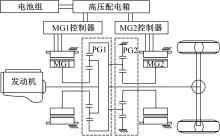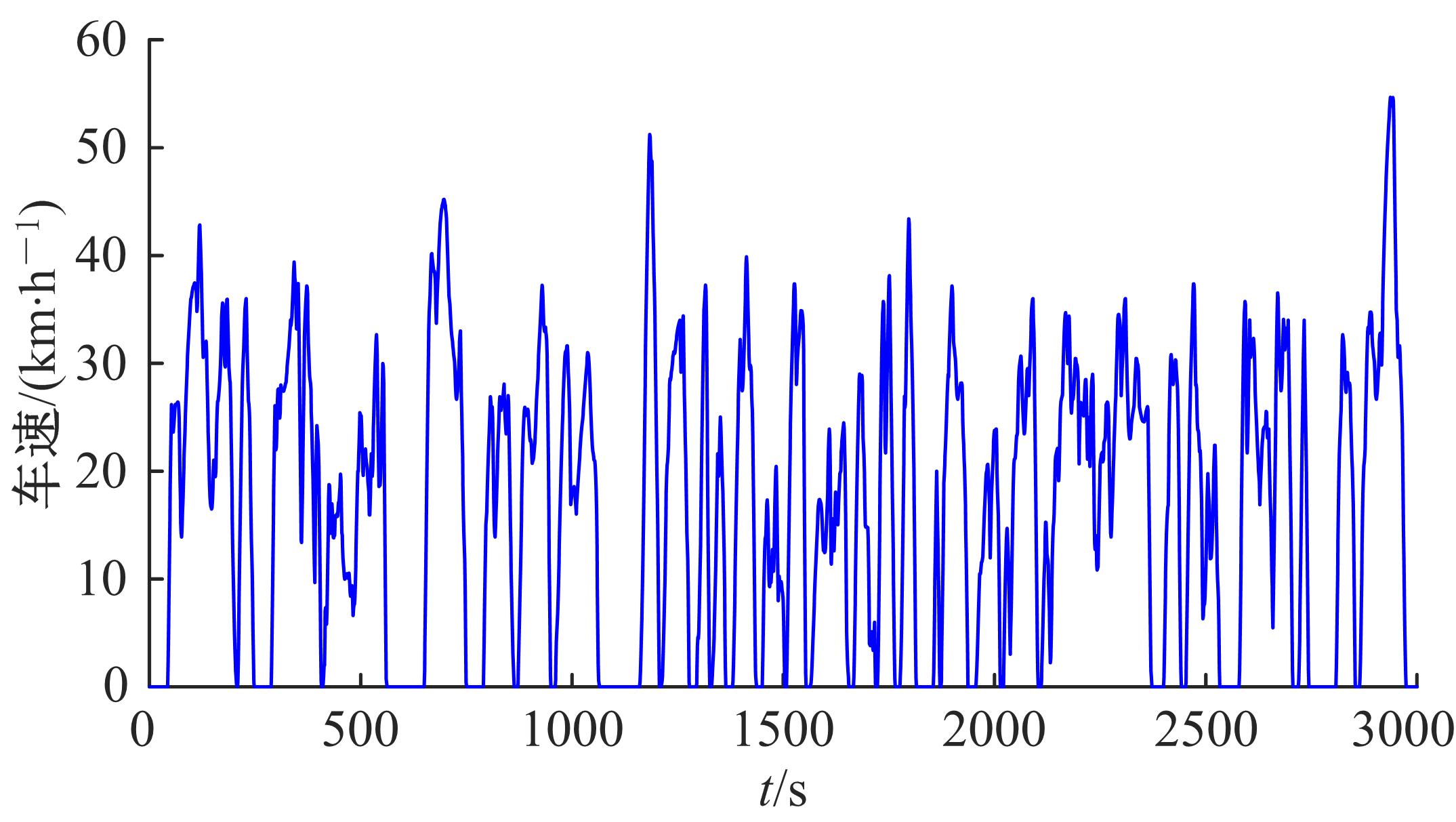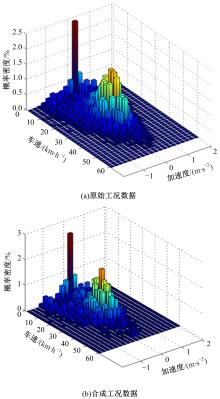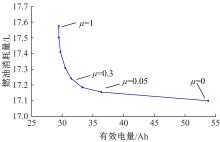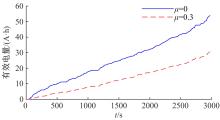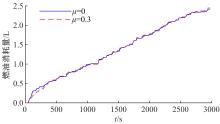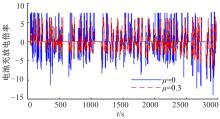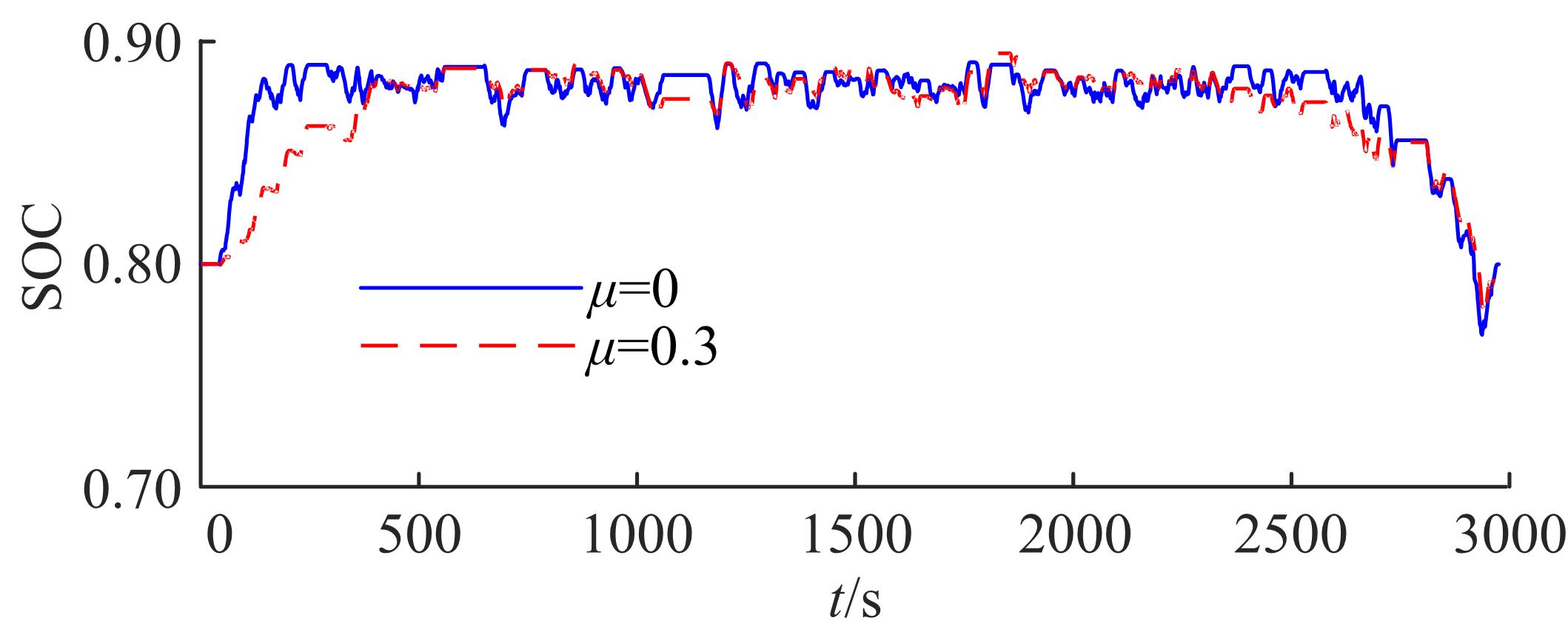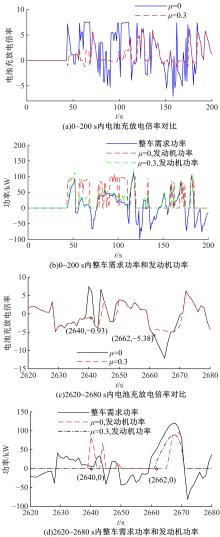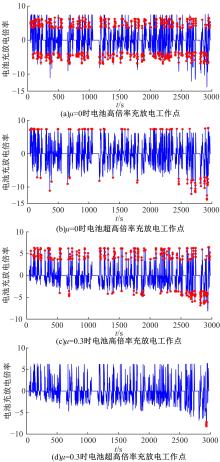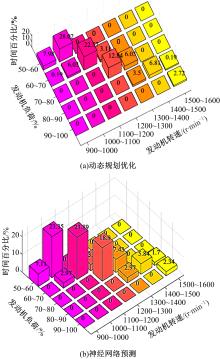Journal of Jilin University(Engineering and Technology Edition) ›› 2021, Vol. 51 ›› Issue (3): 781-791.doi: 10.13229/j.cnki.jdxbgxb20200077
Battery life optimization of hybrid electric vehicle based on driving cycle construction
Da-feng SONG( ),Li-li YANG,Xiao-hua ZENG(
),Li-li YANG,Xiao-hua ZENG( ),Xing-qi WANG,Wei-zhi LIANG,Nan-nan YANG
),Xing-qi WANG,Wei-zhi LIANG,Nan-nan YANG
- State Key Laboratory of Automotive Simulation and Control,Jilin University,Changchun 130022,China
CLC Number:
- U469.7
| 1 | 董婷婷. 增程式电动车能量管理及电池寿命研究[D]. 长春:吉林大学汽车工程学院, 2015. |
| Dong Ting-ting. Study on energy management and battery life for extended-range electric vehicle[D]. Changchun: College of Automotive Engineering, Jilin University, 2015. | |
| 2 | 杨南南. 双行星混联式客车的优化设计与动态控制[D]. 长春:吉林大学汽车工程学院, 2015. |
| Yang Nan-nan. Optimal design and dynamic control of dual planetary hybrid electric bus[D]. Changchun: College of Automotive Engineering, Jilin University, 2015. | |
| 3 | 宋传学, 周放, 肖峰. 基于动态规划的复合电源能量管理优化[J]. 吉林大学学报:工学版,2017,47(1):9-11. |
| Song Chuan-xue, Zhou Fang, Xiao Feng. Energy management optimization of hybrid energy storage system (HESS) based on dynamic programming[J]. Journal of Jilin University (Engineering and Technology Edition), 2017, 47(1):9-11. | |
| 4 | 张风奇, 胡晓松, 许康辉, 等. 混合动力汽车模型预测能量管理研究现状与展望[J]. 机械工程学报,2019,55(10):88-93. |
| Zhang Feng-qi, Hu Xiao-song, Xu Kang-hui, et al. Current status and prospects for model predictive energy management in hybrid electric vehicles[J]. Journal of Mechanical Engineering,2019,55(10):88-93. | |
| 5 | 王静. 基于工况辨识的增程式电动城市客车最优能量分配策略[D]. 北京:清华大学机械工程学院, 2015. |
| Wang Jing. Based on driving pattern recognition optimal energy management strategy of extended-range electric city bus[D]. Beijing: College of Mechanical Engineering, Tsinghua University, 2015. | |
| 6 | 巴懋霖. 基于多工况优化的插电式混合动力汽车控制策略研究[D]. 长春:吉林大学汽车工程学院, 2018. |
| Ba Mao-lin. Research on the control strategy of plug-in hybrid electric vehicle based on multi-condition optimization[D]. Changchun: College of Automotive Engineering, Jilin University, 2018. | |
| 7 | 时玮,张言茹,陈大分, 等. 锰酸锂动力电池寿命测试方法[J]. 汽车工程,2015,37(1):68-70. |
| Shi Wei, Zhang Yan-ru, Chen Da-fen, et al. Lifespan test method for LiMn2O4 traction batteries[J]. Automotive Engineering,2015,37(1):68-70. | |
| 8 | 刘光明. 面向电动汽车续驶里程估计的电池剩余放电能量预测研究[D]. 北京: 清华大学机械工程学院, 2015. |
| Liu Guang-ming. Prediction of battery remaining discharge energy oriented for remaining driving range estimation of electric vehicles[D]. Beijing: College of Mechanical Engineering, Tsinghua University, 2015. | |
| 9 | 宋大凤,云千芮,杨南南, 等. 行星式混合动力客车的模型预测动态协调控制[J]. 哈尔滨工业大学学报,2019,51(1):151-152. |
| Song Da-feng, Yun Qian-rui, Yang Nan-nan, et al. Model predictive dynamic coordinated control of planetary hybrid electric bus[J]. Journal of Harbin Institute of Technology, 2019,51(1):151-152. | |
| 10 | 刘延伟,朱云学,林子越,等. 基于Radau伪谱法的复合电源电动汽车能量管理策略优化[J]. 汽车工程,2019,41(6):626-627. |
| Liu Yan-wei, Zhu Yun-xue, Lin Zi-yue, et al. Energy management strategy optimization of hybrid energy storage system based on radau pseudo-spectral method[J]. Automotive Engineering,2019,41(6):626-627. | |
| 11 | Wang J. Cycle-life model for graphite-LiFePO4 cells[J]. Journal of Power Sources, 2011, 196(8):3942-3948. |
| 12 | 曾小华, 王星琦, 宋大凤, 等. 考虑电池寿命的插电式混合动力汽车能量管理优化[J]. 浙江大学学报:工学版, 2019,53(11):2206-2214. |
| Zeng Xiao-hua, Wang Xing-qi, Song Da-feng, et al. Battery-health conscious energy management optimization in plug-in hybrid electric vehicles[J]. Journal of Zhejiang University (Engineering and Technology Edition), 2019, 53(11):2206-2214. | |
| 13 | Tang L, Rizzoni G, Onori S. Energy management strategy for HEVs including battery life optimization[J]. IEEE Transactions on Transportation Electrification, 2015, 1(3): 211-222. |
| 14 | Suri G, Onori S. A control-oriented cycle-life model for hybrid electric vehicle lithium-ion batteries[J]. Energies, 2016, 96: 644-653. |
| 15 | Onori S, Spagnol P, Marano V, et al. A new life estimation method for lithiumion batteries in plug-in hybrid electric vehicles applications[J]. International Journal of Power Electronics, 2012, 4(3): 302-319. |
| 16 | 秦大同, 詹森, 漆正刚, 等. 基于K-均值聚类算法的行驶工况构建方法[J]. 吉林大学学报:工学版, 2016, 46(2):384-388. |
| Qin Da-tong, Zhan Sen, Qi Zheng-gang, et al. Driving cycle construction using K-means clustering method[J]. Journal of Jilin University (Engineering and Technology Edition), 2016, 46(2):384-388. | |
| 17 | 杨南南. 基于历史数据的行星混联式客车在线优化控制策略[D]. 长春:吉林大学汽车工程学院, 2018. |
| Yang Nan-nan. Historical data based online optimal control strategy for power-spilt hybrid electric bus[D]. Changchun: College of Automotive Engineering, Jilin University, 2018. | |
| 18 | 苗强,孙强,白书战,等. 基于聚类和马尔可夫链的公交车典型行驶工况构建[J]. 中国公路学报,2016,29(11):161-166. |
| Miao Qiang, Sun Qiang, Bai Shu-zhan, et al. Construction of typical driving cycle of bus based on clustering and Markov chain[J]. China Journal of Highway and Transport, 2016, 29(11): 161-166. | |
| 19 | 陈泽宇,杨英,王新超,等. 插电式并联混合动力汽车再生制动控制策略[J]. 东北大学学报:自然科学版, 2016,37(12):1751-1754. |
| Chen Ze-yu, Yang Ying, Wang Xin-chao, et al. Control strategy of regenerative braking for plug-in parallel hybrid electric vehicles[J]. Journal of Northeastern University(Natural Science),2016,37(12):1751-1754. | |
| 20 | 沈登峰, 王晨, 于海生. 复合功率分流混合动力汽车能量管理策略研究[J]. 汽车工程, 2017, 39(1):15-22, 27. |
| Shen Deng-feng, Wang Chen, Yu Hai-sheng, et al. A study on energy management strategy for compound power-spilt hybrid electric vehicle[J]. Automotive Engineering, 2017, 39(1): 15-22, 27. | |
| 21 | 詹森, 秦大同, 曾育平. 基于遗传优化K均值聚类算法工况识别的混合动力汽车能量管理策略[J]. 中国公路学报,2016,29(4):131-136. |
| Zhan Sen, Qin Da-tong, Zeng Yu-ping. Energy management strategy of HEV based on driving cycle recognition using genetic optimized K-means clustering algorithm[J]. China Journal of Highway and Transport, 2016,29(4):131-136. |
| [1] | Jia-xu ZHANG,Xin-zhi WANG,Jian ZHAO,Zheng-tang SHI. Path planning and discrete sliding mode tracking control for high⁃speed lane changing collision avoidance of vehicle [J]. Journal of Jilin University(Engineering and Technology Edition), 2021, 51(3): 1081-1090. |
| [2] | Rong QIAN,Ru ZHANG,Ke-jun ZHANG,Xin JIN,Shi-liang GE,Sheng JIANG. Capsule graph neural network based on global and local features fusion [J]. Journal of Jilin University(Engineering and Technology Edition), 2021, 51(3): 1048-1054. |
| [3] | Wei-da WANG,Yan-jie WU,Jia-lei SHI,Liang LI. Electronic hydraulic brake power system control strategy based on driver intention recognition [J]. Journal of Jilin University(Engineering and Technology Edition), 2021, 51(2): 406-413. |
| [4] | Guo-ying CHEN,Jun YAO,Peng WANG,Qi-kun XIA. Stability control strategy for rear in⁃wheel motor drive vehicle [J]. Journal of Jilin University(Engineering and Technology Edition), 2021, 51(2): 397-405. |
| [5] | Fu-hua SHANG,Mao-jun CAO,Cai-zhi WANG. Local outlier data mining based on artificial intelligence technology [J]. Journal of Jilin University(Engineering and Technology Edition), 2021, 51(2): 692-696. |
| [6] | Shou-tao LI,Rui WANG,Jing-chun XU,De-jun WANG,Yan-tao TIAN,Ding-li YU. A vehicle collision avoidance control method based on model predictive composite control [J]. Journal of Jilin University(Engineering and Technology Edition), 2021, 51(2): 738-746. |
| [7] | Lu XIONG,Yan-chao WEI,Le-tian GAO. Inertial measurement unit/wheel speed sensor integrated zero-speed detection [J]. Journal of Jilin University(Engineering and Technology Edition), 2021, 51(1): 134-138. |
| [8] | Fang-wu MA,Hong-yu LIANG,Qiang WANG,Yong-feng PU. In-plane dynamic crushing of dual-material structure with negative Poisson′s ratio [J]. Journal of Jilin University(Engineering and Technology Edition), 2021, 51(1): 114-121. |
| [9] | Xiao-hui WEI,Bing-yi SUN,Jia-xu CUI. Recommending activity to users via deep graph neural network [J]. Journal of Jilin University(Engineering and Technology Edition), 2021, 51(1): 278-284. |
| [10] | Dao WU,Li-bin ZHANG,Yun-xiang ZHANG,Hong-ying SHAN,Hong-mei SHAN. Visual detection method for vehicle braking time sequence based on slip rate identification [J]. Journal of Jilin University(Engineering and Technology Edition), 2021, 51(1): 206-216. |
| [11] | En-hui ZHANG,Ren HE,Wei-dong SU. Numerical analysis of oil liquid sloshing characteristics in fuel tank with different baffle structures [J]. Journal of Jilin University(Engineering and Technology Edition), 2021, 51(1): 83-95. |
| [12] | Fei GAO,Yang XIAO,Wen-hua ZHANG,Jin-xuan QI,Zi-qiao LI,Xiao-yuan MA. Influence of coupling of elevated temperature and state of charge on mechanical response of Li⁃ion battery cells [J]. Journal of Jilin University(Engineering and Technology Edition), 2020, 50(5): 1574-1583. |
| [13] | Jing LI,Qiu-jun SHI,Liang HONG,Peng LIU. Commercial vehicle ESC neural network sliding mode control based on vehicle state estimation [J]. Journal of Jilin University(Engineering and Technology Edition), 2020, 50(5): 1545-1555. |
| [14] | Guo-hua LIU,Wen-bin ZHOU. Pulse wave signal classification algorithm based on time⁃frequency domain feature aliasing using convolutional neural network [J]. Journal of Jilin University(Engineering and Technology Edition), 2020, 50(5): 1818-1825. |
| [15] | Chang-qing DU,Xi-liang CAO,Biao HE,Wei-qun REN. Parameters optimization of dual clutch transmission based on hybrid particle swarm optimization [J]. Journal of Jilin University(Engineering and Technology Edition), 2020, 50(5): 1556-1564. |
|
||
